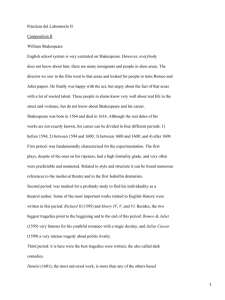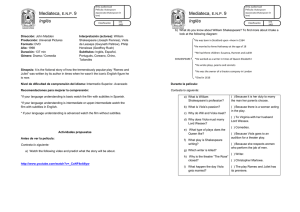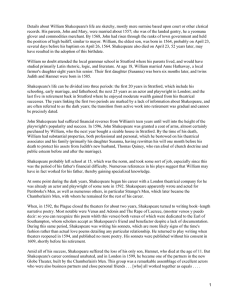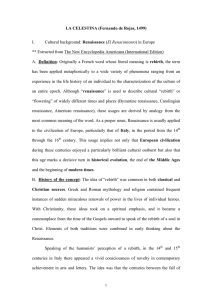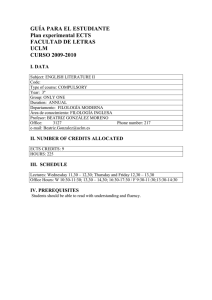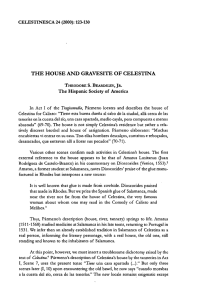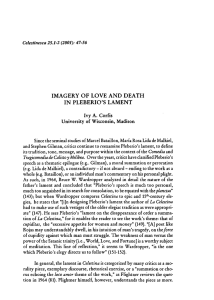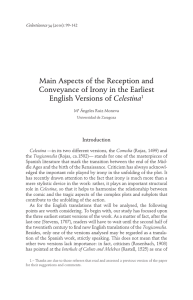Rojas` Old Bawd and Shakespeare`s Old Lady: Celestina
Anuncio
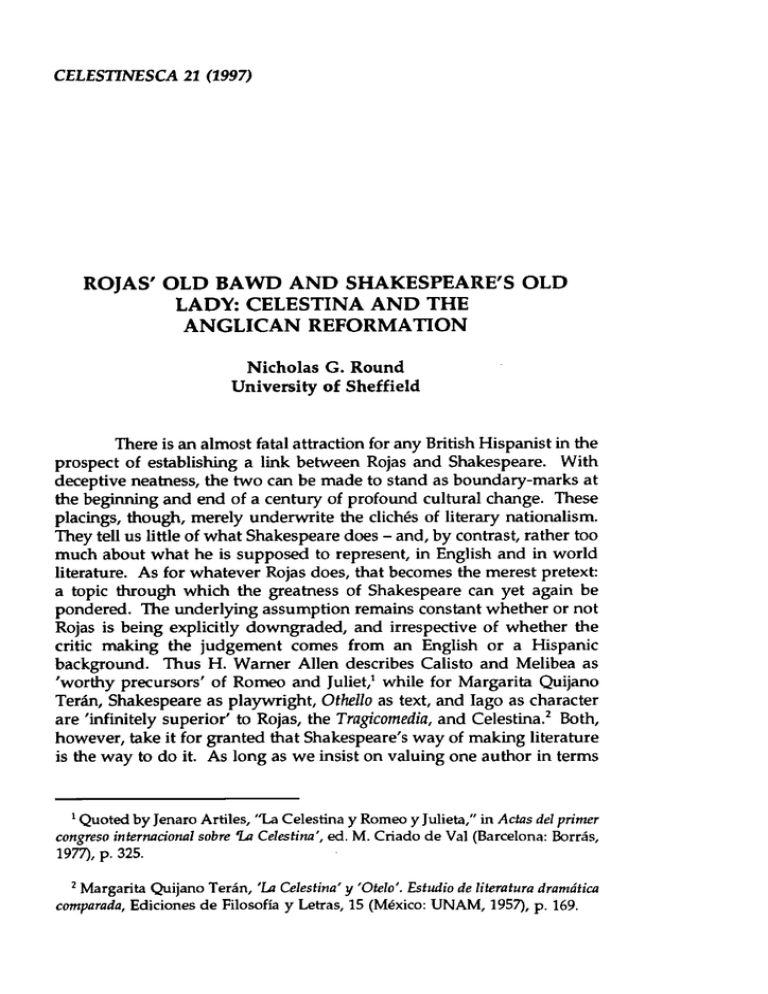
ROJAS' OLD BAWD AND SHAKESPEARE'S OLD
LADY: CELESTINA AND THE
ANGLICAN REFORMATION
Nicholas G . Round
University of Sheffield
There is an almost fatal attraction for any British Hispanist in the
prospect of establishing a link between Rojas and Shakespeare. With
deceptive neatness, the two can be made to stand as boundary-marks at
the beginning and end of a century of profound cultural change. These
placings, though, merely underwrite the cliches of literary nationalism.
They tell us little of what Shakespeare does - and, by contrast, rather too
much about what he is supposed to represent, in English and in world
literature. As for whatever Rojas does, that becomes the merest pretext:
a topic through which the greatness of Shakespeare can yet again be
pondered. The underlying assumption remains constant whether or not
Rojas is being explicitly downgraded, and irrespective of whether the
critic making the judgement comes from an English or a Hispanic
background. Thus H. Warner Allen describes Calisto and Melibea as
'worthy precursors' of Romeo and Juliet,' while for Margarita Quijano
Terh, Shakespeare as playwright, Othello as text, and Iago as character
are 'infinitely superior' to Rojas, the Tragicomedia, and Cele~tina.~
Both,
however, take it for granted that Shakespeare's way of making literature
is the way to do it. As long as we insist on valuing one author in terms
Quoted by Jenaro Artiles, "La Celestina y Romeo y Julieta," in Actas del primer
congreso international sobre Za Celestina', ed. M. Criado de Val (Barcelona: Borrds,
1977), p. 325.
Margarita Quijano Terdn, 'La Celestina' y 'Otelo'. Estudio de literatura dmma'tica
comparada, Ediciones d e Filosofia y Letras, 15 (Mexico: UNAM, 1957), p. 169.
94
NICHOLAS G. ROUND
deriving from the achievements of the other, there is not much to be
learned from bringing the two great names into conjunction.
Yet attempts to define their difference can run just as readily into
platitude. Juan Pedro Barricelli, for example, classes Iago as an 'essential'
character and Celestina as an 'existential' one, only to lapse into the tired
and suspect topos of 'Spanish reali~m'.~This seems a pity, because so
much that is authentically original in Rojas does, in fact, relate to that
polarity of the 'essential' and the 'existential'. We might clarify the point
by rephrasing it in terms at once more nearly contemporary with Rojas
himself and more narrowly linguistic in their reference. Celestina is
remarkable as a piece of writing which combines realist discourse realist, that is, in the philosophical sense - with nominalist discourse.
Whether construed as the author's rhetorical medium or as the
characters' particular utterance, its language blends these elements
inextricably together. Time and again, universal judgements are asserted,
only to be brought under a commentary that is localized, specific, and
deeply corrosive. In that sense (and especially in Celestina's own
speeches) the nominalist, existential strand very clearly does prevail. Yet
the thing which gives the language of Celestina as a whole its power to
matter to us - to be credible, dangerous, urgent - is just this fact of its
being, in such cases, a mixed language.
That fact must shift the focus of discussion, if only provisionally,
back to possible affinities with Shakespeare, much of whose language is
itself 'mixed' in just this sense. Other readers, notably Maria Rosa Lida
de Malkiel, have identified a Shakespearian quality in Rojas' way of
imagining his character^.^ Again, it is not too hard to see what is meant.
But we are left, in both instances, with a problem. . It is that of
determining whether we come to recognize these qualities primarily
through Rojas' making of his text or through our own reading of it. If
the latter, we need to bear in mind how far that reading itself is bound
to have been shaped in advance by the experience of reading
Shakespeare. The likeness may be there only in the sense that we have
found ourselves able to put it there.
Juan Pedro Barricelli, "La Celestina y la naturaleza del mal," Cuadernos
Americanos 40.2 (1981), p. 75.
'
Maria Rosa Lida de Malkiel, La originalidad artktica tie 'La Celestina' (Buenos
Aires: EUDEBA, 1962,19703, pp. 283-88; the reservations expressed by Stephen
Gilman, The Spain ofFemando de Rojas: The intellectual nnd Social Landscape of 'La
Celestina' (Princeton: Princeton UP, 1972), pp. 13-17, are much to the point.
Some such dilemma, indeed, seems barely separable from our
having any knowledge at all regarding literary texts. The process by
which that knowledge comes into being can be characterized, partially
but still convincingly, as a constant alternation and interaction between
makings and readings. Celestina itself offers one very striking example.
Because we are able to read all the later Acts, and to do so with
reasonable confidence that they are the work of Femando de Rojas, we
also tend to read Act I as though it were his. If Act I were all that we
had, we should read it very differently. This is not merely a matter of
our seeing its plot as developing towards an unexpectedly serious end;
it has to do with the meanings and effects which we are disposed to find
in it. And here at last we do seem to arrive at something which Rojas
and Shakespeare can be said, with fair objectivity, to have in common.
Both, through the distinctive making of their texts, promote practices of
reading which would have been altogether less likely to develop had
those texts not been made in those specific ways.
Self-evidently, Rojas had no opportunity to take up the new
modes of reading promoted by Shakespeare's making of texts: he died
far too soon for that. But Shakespeare could - at least in chronological
terms - have practised ways of reading made possible, in the first
instance, by Rojas' making of Celestina. He might have applied these to
his own reading of the Tragicomedia or of any number of other texts. It
is worth asking, then, whether he had any actual (as opposed to merely
notional) possibilities of doing these things, and whether in fact he did
them; whether a reading of Rojas has left any traces in his work, and
above all, supposing that he did read Rojas, how he read him. The point
of these questions, though, is not that they enable us associate one wellregarded literary figure with another. Rather, their purpose is to clarify
the interplay of makings, readings, and historico-cultural experiences (the
third element in the literary process) at moments when it seems to have
been working to maximum effect.
We may assume - for lack of any positive evidence - that
Shakespeare could not have read Celestina in Spanish. It is notionally
possible, but not more, that he could have known one or other of the two
French versions current in his time.' But if we set aside these and a few
The anonymous first version has been edited by Gerald J. Brault, 'Celestine':
A Critical Edition of the First French Translation (1527) of the Spanish Classic 'La
Celestina' (Detroit:Wayne State UP, 1963). Likelier to have come to Shakespeare's
notice was Jacquesde Lavardin's rendering, now edited by Denis L. Drysdall, 'La
Celestina' in the French translation of1578 by Jacques de Lavardin (London: Tamesis,
96
NICHOLAS G. ROUND
other largely speculative scenarios, we are left with four reasonably
well-documented channels through which he could have come to a
knowledge of Rojas' work.6 The first relevant text, already in print by
around 1530, was the Interlude of Calisto and Melibea. In this brief
adaptation Melibea remains unseduced: she repents in the nick of time,
and is reconciled with her father (here called Danio). Despite this
truncated story-line, the Interlude is an intelligently adapted and
effectively dramatized piece of work? But it belongs to a very early
phase indeed of secular theatre in England: the appropriate Spanish
comparisons would be with Tomes Naharro, or even with Juan del
Encina. It is hard to see such a text as influential for a radically
innovatory playwright, at work in the very last years of the century.
The second possibility is hinted at in some remarks on prevailing
theatrical tastes made by the Puritan critic Anthony Munday in a polemic
against the stage, composed in 1580. The comedies of his time, he
declares, are 'like the tragical Comedie of Calistus; where the bawdresse
Scelestina inflamed the maiden Melibeia with her sorceries' (Brault, 310).
That, as we have seen, was not theoutcome of the Interlude. Moreover,
the phrase 'tragical Comedie' seems to echo the main textual tradition of
Celestina's title. Perhaps Munday had read the Tragicomedia in French, or
even in Spanish. But that would not, of itself, render his allusion as
transparent as it needed to be for the public he was addressing. The
likeliest inference, then, is that he was referring to some recent
adaptation of Celestina for the English stage, now irretrievably lost.
Again lost, but much more directly attested is the third of our
possibilities. On 5th October 1598 the printer William Apsley entered in
the Stationers' Register 'a book intituled. The tragick Comedye of
The bibliographical background is lucidly set out by Brault, "English
Translations of the Celestina in the Sixteenth Century,"Hispanic Review 28 (1960):
301-12, and summarized in Guadalupe Martinez Lacalle, 'Celestine' or the Tragick
Comedie ofCalisto and Meliben. Translated by lames Mabbe (London:Tamesis, 1972),
pp. 2-6. Artiles, pp. 330-31 is less securely-based, building injudiciously on a
Stationers' Register entry of 1591 which probably refers to a projected reprint in
Spanish (Brault, "EnglishTranslations,"pp. 30748.
' See Albert J. Geritz, "Calisto and Melibea: A Bibliography," Celestinesca 3.2
(1979):45-50. Text in J. S. Farmer, ed., Six Anonymous Plays. First Series (c.15101537),Early English Dramatists (London:Early English Drama Society: 1905), pp.
47-87.
ROJAS' OLD BAWD AND SHAKESPEARE'S OLD LADY
97
Celestina / wherein are discoursed in most pleasant stile manye
Philosophical1 sentences and advertisementsverye necessarye for Younge
gentlemen. Discoveringe the sleights of treacherous servants and the
subtile cariages of filthye bawdes' (Brault, 308). About the filiation of this
in the Celestina tradition there is scarcely room for doubt: what Apsley
had in view was a translation of the Tragicomedia. On the other hand, we
simply do not know whether it was actually printed but has since
disappeared, or existed at that time but only in manuscript, or never got
beyond being a mere project for a translation.
Finally there is James Mabbe's English version. That did not see
print until 1631. But at the head of the manuscript text published some
years ago by Guadalupe Martinez Lacalle there is a prose dedication to
John Strangeways, Esquire; by 1611, Strangeways had been knighted. At
the end of the same text there appears a sonnet dedicated by the
translator to the 'right worthie Knight' George Trenchard the Younger;
the date of Trenchard's knighthood was 1603. Mabbe's Celestina, then,
in this state of the text, was already in existence at some time between
those two dates! It could, of course, have been composed before 1603,
and the sonnet to Trenchard added later. It is even possible that it
could have been Mabbe's version which Apsley intended printing in
1598. Mabbe would have been about twenty-six at the time. And
although he spent most of his life in Magdalen College, Oxford (apart
from various diplomatic missions to France and Spain), it is perfectly
possible too that he knew Shakespeare. In 1623 he was one of the poets
from whom the editors of the First Folio sought and obtained a set of
commemorative verse^.^
There is no very obvious way in which these possibilities of
contact with the Celestina tradition ought to be correlated with those
plays of Shakespeare in which alleged traces of such contact have from
time to time been discerned.'' Romeo and Iuliet offers a theme - the
Martinez Lacalle, pp. 105-09 (dedication to Strangeways), 268 (verses to
Trenchard), 34-35 (consequences for dating).
Biographical details in Martinez Lacalle, pp. 7-13 (pp. 13-14 for the First Folio
verses); also P. E. Russell, "A Stuart Hispanist:James Mabbe," Bulletin ofHispanic
Studies 30 (1953), 75-84 (possible Shakespearian links, 76, 79-80).
'O On Romeo and Iuliet see especially Artiles; also Pedro Juan Duque Diaz de
Cerio, "La presencia de Espaiia en Romeo y Julieta," Letras de Deusto 9 (1979): 6394; on Othello, Quijano Terh; also Barricelli. Lida de Malkiel, La originalidad (189go), points to other Celesh'm-like time-schemes in Hamlet, Troilus and Cressida, and
98
NICHOLAS G. ROUND
doomed lovers - and a character - Juliet's nurse - whose interest in this
regard is obvious. Yet at the time of its writing, in 1594 or 1595,
Shakespeare had at his disposal only the Interlude (if anyone at all
remembered the interlude by then), or still more problematically, the
adaptation apparently referred to by Anthony Munday. Othello, of 1603
or 1604, has in Iago a Celestinesque character of its own; like Celestina
too, it employs a double time-scheme to dramatize a tale of passion.
And by that date, certainly, Shakespeare could have known Mabbe's
translation. Curiously, though, the supposed influence bears much the
same indirect character in both these instances. In neither case do those
elements which are paralleled in Rojas' work begin, by any measure, to
exhaust the thematic and dramatic range of the Shakespearian text.
On the other hand, neither Iago nor the Nurse can be said to
embody anything like the full range of Celestina's attributes. On the
contrary, each of them seems to take up a different selection of these.
The Nurse is the indispensable go-between, facilitating a forbidden love;
she even seems to display a certain human spontaneity, by contrast with
the rigid codes of family honour. Iago has at his command a Celestinalike rhetoric of temptation and moral disorientation, and the self-interest
from which he operates merges, like hers, into an almost disinterestedly
destructive malice. But Celestina's own pattern of activity subsumes
both sets of attributes. She is at one and the same time indispensable
and destructive, profoundly human and radically monstrous. In that
sense, the character in whom Shakespeare seems to respond most fully
to Rojas' example is Falstaff - not a Celestinesque figure at all, though he
does frequent a Celestinesque world."
And he makes his first
appearance in Hen y IV in 1597 or 1598, just when the English Celestina
registered by Apsley might have been starting to circulate in manuscript
form. As evidence, that timing is far from conclusive, but it is not
without interest either.
Two Gentlemen of Verona (this last, surely, too early for any influence to be at all
probable).
On Falstaff see Laurence Senelick, "The Bard and the Bawd," Prologue 30.2
(November 1974), 1. Further specific resemblances to Celestina in Shakespeare's
plays are adduced by Lida de Malkiel, Two Spanish Masterpieces: The 'Book ofGood
Love' and the 'Celestina', Studies in ~anguageand Literature, 49 (Urbana:U Illinois
P, 1961), p. 96: King John, Twelfth Night, Much Ado About Nothing, and even the
very early Love's Labours Lost. Most of these (and the many others touched upon
in La originalidnd, passim) seem as likely to be cases of analogy as of actual
influence.
l'
A more specific echo has been suggested by Albert Bagby and
William Carroll in the case of A Winter's Tale (1611).12 Here
Shakespeare represents the young Prince Florizel as being led by the
flight of his falcon to the enclosure ('Thy father's ground') where his
beloved lives. The motif is too widely diffused for this to prove any
textual link with Calisto and the opening of Celestina. Besides, the happy
consequences of Florizel's encounter with Perdita are at an opposite pole
from what happens after Calisto has met Melibea. Yet the resemblance
does arise at one of the likeliest times for personal contact between
Shakespeare and James Mabbe. Like Henry VIII, to which we shall return
presently, A Winter's Tale belongs to the last group of plays which
Shakespeare wrote. Frances Yates has shown how these pieces are linked
ideologically with the political hopes which King James I centred on his
two older children, Henry and Eli~abeth.'~Mabbe, for his part, had
close ties with members of Prince Henry's entourage, and especially with
Sir John Digby. In 1610 Digby chose him for inclusion in his forthcoming
embassy to Madrid, for which Magdalen College granted him leave of
absence on 31st December. Mabbe did not leave England, however, until
April 1611. Almost certainly he spent the early months of that year - the
year of A Winter's Tale - in London.14
Based in Madrid for the next four years, Mabbe can have played
no direct part in the story of Shakespeare's later output. prince Henry
too was to disappear from the picture, dying in November 1612. But the
enormous burden of public expectation which he had carried, with all its
hopes of revived Elizabethan glory was not immediately dissipated;
instead, it was now transferred to his sister Elizabeth and to Frederick,
Prince of the Palatinate, whom she married in London in February 1613.
The historical drama Henry V111 bears every appearance of being
Shakespeare's contribution (in collaboration, probably, with John
Albert J. Bagby, Jr and William M. Carroll, "The Falcon as a Symbol of
Destiny: De Rojas and Shakespeare," Romanische Forschungen 83 (1971): 306-10;
see, for the wider background, Donald McGrady, "The Hunter Loses his Falcon:
Notes on a Motif from Cligb to La Celestina and Lope de Vega," Romania 107
(1986): 145-82.
l2
* Frances Yates, Shakespeare's Last P1ays:A New Approach (London:Routledge,
1975), pp. 17-35.
Martinez ~acalle,p. 9; Russell, 77. I accept here the dating (a little later
than some others) proposed for A Winter's Tale by Yates, p. 10.
l'
100 NICHOLAS G. ROUND
Fletcher) to the public festivities surrounding that marriage.15 It deals
with events which were crucial for the future greatness of the Tudors
and the eventual triumph of Protestantism in England. The name of King
Henry, who is shown as growing in prudence and authority throughout
the play, also recalled the recently lamented prince. The prophetic
speech with which the drama ends promises glory for another Princess
Elizabeth and for her successors. The culminating point in a whole array
of patriotic spectacle and ceremony is the coronation of Anne Boleyn itself closely and causally linked with another royal marriage. The date
of the piece in early 1613 seems confirmed by the description of it as a
'new play' in an eye-witness account of its most celebrated
perf~rrnance.'~ This was the occasion in late June 1613 when the
careless discharge of one of the artillery pieces used in the ceremonial
scenes led to a fire in the thatch and the destruction of the entire Globe
Theatre. The possibly excessive realism of these elements of spectacle underlined by the alternative title All is True - also appears to connect
with a propagandist purpose.
Being in this sense an occasional piece, late in date and with
some doubt attaching to its authorship, Hen y V111 has, unsurprisingly,
received less critical comment than most of Shakespeare's other output.
No doubt for &at reason, attention does not hitherto seem to have been
drawn to the presence in its cast-list of one of Shakespeare's most
obviously Celestinesque figures. The cast is a large one, of almost forty
named parts. Of these, twenty-five have proper names, deriving from
the dramatist's historical sources. Twelve bear the titles of their public
or domestic offices: Garter King-at-Arms, a Porter, and so forth. Three
anonymous 'Gentlemen', acting as the mouthpieces of wider public
opinion, comment from time to time on the developing plot. There
remain two named characters who are wholly of the author's own
invention: the confidantes, respectively, of Queen Katherine and of Anne
Boleyn. To Katherine's friend and counsellor Shakespeare gives an
R. A. Foakes, ed., King Henry VIII, The Arden Edition of the Works of
Shakespeare (London:Methuen, 1957), xxviii-xxxiii; also John Margeson, ed., King
Henry V111, The New Cambridge Shakespeare (Cambridge: UP, 1990), pp. 3-4;
Yates, p. 67.
lS
Letter of Sir Henry Wotton, 2nd July 1613 (text in Foakes, p. 180, with other
contemporary reports). The date of the interrupted performance was 29th June.
l6
ROJAS' OLD BAWD AND SHAKESPEARE'S OLD LADY
101
allegorical name: Patience. Anne's confidante is described simply as 'An
Old Lady'?'
The two scenes in which the Old Lady appears (11, iii and V, i)
present no problems of authorship: they are universally accepted as being
by Shakespeare and not by any collaborator."' In the earlier scene,
Anne and the Old Lady discuss the troubles of the Queen, an innocent
victim of her husband's estrangement. Anne raises the topic of contented
poverty; the Old Lady concurs. But when Anne protests that 'By my
troth and maidenhead,/ I would not be a queen', the reply is swift and
contemptuous: 'Beshrew me, I would,/ ...and so would you'. And with
an unstoppable flood of sexual double entendre, the Old Lady urges on her
mistress the many advantages of worldly greatness. They are interrupted
by the Lord Chamberlain, who wants to know what they were talking
about. 'Our mistress' sorrows we were pitying', Anne replies - an
answer which greatly impresses her visitor. 'It was a gentle business, and
becoming/ The action of good women', he observes complacently, and
goes on to announce that the King has just made Anne the Marchioness
of Pembroke, with a thousand pounds a year. The Old Lady celebrates
the news with more jibes against the modesty of Anne's ambitions; the
latter does not waver in her views, but does ask her companion to keep
the matter of their conversation secret. What do you think me?' answers
the Old Lady as the scene ends.
In Act V, King Henry is anxiously waiting for news of his new
wife's childbed. He has just had an interview with the earnest and
virtuous Archbishop Cranrner, to whom he has promised support against
the intrigues of his enemies. At this point the Old Lady rushes in,
thrusting the royal guards aside. 'Is the Queen deliver'd?' demands the
King, 'Say ay, and of a boy.' The Old Lady hedges her reply:
Foakes, p. 2; also p. 68 (the list of Dramatis Personae is an editorial
extrapolation from earlier texts). All quotations from the play here are taken from
this edition.
l'
* Texts in Foakes, pp. 68-75, 153-54; on authorship see ibid, pp. xviii-xxvi;
also Margeson, pp. 4-14. Both editors see Fletcher's contribution to the play as
more limited than has traditionally been claimed. In the present context, it seems
worth noting that Shakespeare and Fletcher also appear to have collaborated at
about the same date on the lost play Cardenio, whose title suggests a Spanish
theme (see MacD. P. Jackson, "The Transmission of Shakespeare'sText," in The
Cambridge Companion to Shakespeare Studies, ed. Stanley Wells (Cambridge: UP,
1986), p. 165.
102 NICHOLAS G. ROUND
...Ay, ay, my liege,
And of a lovely boy: the God of heaven
Both now and ever bless her: 'tis a girl
Promises boys hereafter.
Henry hurries off to visit his wife and the new arrival ('as like
you/ As cherry is to cherry'), ordering his servant, as he goes, to give the
Old Lady a hundred marks. She is -not impressed: it is payment fit only
for a groom. 'Said I for this the girl was like to him?' she grumbles, 'I'll
have more, or else unsay 't'. And off she goes to stake her claim.
The possible echoes of Celestina in all this are obvious enough.
One is bound to wonder in the first place why Anne Boleyn's companion
had to be an old lady rather than a young one. Besides, her
interventions bear a strikingly Celestina-like character: the deceptive
acquiescence in ethical commonplace; the strong incitement to a sexual
liaison that will bring worldly advancement with it; the role of a
messenger who shamelessly manipulates the content of her message. At
certain key moments she helps to facilitate the action; yet her mode of
expression bids fair to dissolve any notion of stable values in a way that
can issue only in chaos. That implicit threat, it is true, remains implicit,
and at the level of verbal expression only: the known course of historical
events would scarcely have allowed for anything else. But only a very
specific imaginative vision of those events would have determined that
Anne Boleyn's hopes of grkatness should be presented first in a language
awash with crude sexual suggestion, or that the birth of the future Queen
Elizabeth should be announced in such equivocal terms as these. It is a
vision which we might well wish to describe as Celestinesque.
It is, of course, true that the elaboration of secondary meanings
of a sexual kind was a wholly characteristic feature of Shakespeare's own
use of language. It was this which so disgusted Bemard Shaw in the
exchanges between Beatrice and Benedick; it is much to the fore in
Mercutio, and in a host of other instances. There is nothing unique even
in the density with which these allusions are heaped one upon another:
the 'soft cheveril conscience' - at once conscience and pudendum, open
and accommodating as a kidskin glove; the 'threepence bow'd' - bent
coin or cut-price bawd; 'queen' in its dual sense of sovereign or harlot;
'pluck off', meaning either 'curb your speculations' or 'get undressed';
the 'young count', the 'emballing', the 'burthen' for the back that
represents sexual co~pling.'~None of this requires to be explained by
l9
King Henry V111,11, iii, 11. 32-47 passim (Foakes, pp. 71-72).
ROJAS' OLD BAWD AND SHAKESPEARE'S OLD LADY
103
Rojas' influence or anyone else's. What does tend to support the notion
of a debt to Celestina is the deployment of such matter within the
dialogue, and the relational pattern which this reveals. Like Melibea (or
like PBrrneno), Anne Boleyn has just asserted an ethical position which
appears to be correct, seriously held, and secure. The Old Lady replies,
with an irresistible verbal force, 'No: this and this and this is what you
really feel; this - you cannot deny it - is what you are.' Though the
contexts and the content are different, that is what Celestina does too.
In her other scene again, the Old Lady says nothing especially close to
what Celestina says; but she does with the truth what Celestina does
with it all the time, reshaping it with the sole aim of her own advantage.
If that is how Rojas' influence works here, one would not expect
it to be particularly evident in direct quotation or imitation. Even so,
there are in these Shakespearean passages a number of apparent verbal
traces of Mabbe's or Rojas' language. The tuming-point of the first
dialogue:
ANNE: I would not be a queen.
OLD LADY: Besluew me, I would,echoes Celestina's response to PArmeno in Act I:
PARMENO:
No querria bienes mal ganados.
CELESTINA: Yo si.. .
which Mabbe, like Shakespeare, amplifies with a mild oath: 'Marrie, Sir,
but so would I.'" The Old Lady stresses the value of 'eminence,
wealth, sovereignty1 as 'blessings' (11, iii, 1. 29), rather as Sempronio
hsists that if the gifts of Fortune are lacking 'a ninguno acaece en esta
vida ser bienaventurado'(p. 38) - though Mabbe, at this point, prefers the
more neutral 'happy' to 'bles~ed'.~~
The persuasion of Anne Boleyn, like
that of Melibea by Celestina in Act IV, has as its point of departure the
topic of contentment in poverty; the key element, repeated in Mabbe
Martinez Lacalle, p. 145; cf. King Henry V111, IT, iii, 1. 24, and Rojas' text in
Celestina, with the Translation of James Mabbe (1631), ed. Dorothy Sherman Severin
(Warminster: Aris & Phillips, 1987), p. 70. This is the edition used here for all
quotations from Rojas, and from the 1631 text of Mabbe; quotations from the
Mabbe MS are taken from Martinez Lacalle.
Martinez Lacalle, p. 127 (but cf. five lines earlier, "those better sorte of
blessinges").
104 NICHOLAS G. ROUND
-'live contentedly'. .. 'Trewe contentednes'(p. 170) - perhaps finds an
echo in the double occurrence of 'content' in Shakespeare's text (11, iii, 11.
20, 22-23).22
The more interesting feature here, though, is' the Old Lady's
double-edged use of the maxim 'Our content is our best having' (11, iii,
11.22-23). Looking back towards Anne's previous remarks, this merely
reaffirms that true wealth consists in having a quiet mind; looking ahead
to the case for ambition which the Old Lady is about to make, it means
'the important thing in life is to get what satisfies us.' There is no
equivalent to this in Rojas here, but it is the kind of thing which
Celestina does with moral sentences time and again. The ending of this
dialogue brings us much closer once more to Celestina and Melibea: the
'innocent' party to the exchanges gives her first clear sign of complicity
by begging her temptress to keep their conversation secret. Celestina,
like the Old Lady, is indignant at the very suggestion that she might do
otherwise: 'Mucho me maravillo, seiiora Melibea, de la duda que tienes
de mi secreto1(p.l34) In the manuscript of Mabbe's version this protest
is attenuated - 'Doubt not, madam, of my seacresie.. .' (p. 178) - but the
lacuna which follows could well conceal something more complete and
emphaticu As for the Old Lady's second intervention, it may not be
irrelevant to recall the words with which Sempronio enquires after the
result of that first interview with Melibea: 'Dime si tenemos hijo o hija'
(p.142). There is another gap in the manuscript at this point (p. 181), but
the 1631 edition has 'Say, is it a son or daughter?' (p. 143).
It seems likely enough, then, that behind the character of the
Old Lady there lies a reading (or a re-reading) of Mabbe's Celestina. It
could have happened during, or perhaps a little after, those early months
of 1611 when Mabbe, preparing in London for his departure with
Digby's embassy to Madrid, is likeliest to have been in personal contact
with Shakespeare. The latter, it would seem, would have had access to
a copy of Celestina differing in some matters of detail from the
manuscript version which survives now. But we are clearly not dealing
with a case of detailed and deliberate imitation. If he did, in fact, make
use of Mabbe in the ways so far indicated, Shakespeare was reworking
The verbal (as opposed to thematic) parallels with Rojas' original are not
especially close here (cf. Severin, p. 116).
" Contrast the 1631 text in Severin, p. 135: "Madame, I much marvel you
should entertain any the least doubt of my servie" [sic], and cf. King Henry VIII,
U, iii, 1. 107.
ROJAS' OLD BAWD AND SHAKESPEARE'S OLD LADY
105
spontaneously various elements, picked up in the course of an attentive
reading.
Spontaneous these responses might be, but they must still
have obeyed some sort of intention. Their relation to the propagandist
drive which so patently underlies other aspects of Heny Vlll is, even so,
hard to establish in any straightforward fashion. Even on an ideological
level there was something radically ambiguous about James 1's grand
dynastic design. Was he claiming for the House of Stuart the leadership
of Protestant Europe? Or did he aspire to make his own monarchy into
something more exalted still: the promoter and guarantor of a universal
accord among all Christian nations? The political dilemma which this
represented was lying in wait for James in the fairly imminent future.
For the moment, however, an imaginary re-creation of historical events
could evade that awkward choice." Hence the sympathetic presentation
in Heny V111 of such sharply opposed figures as Queen Katherine and
Thomas Cranmer. This feature has led critics to characterize the play as
'eclectic', 'tolerant', 'kindly', and 'accommodating'- all of which, in some
measure, it is.* Yet it still narrates, with patent approval, key episodes
in the origins of the English Reformation; in its final tableau the first
Archbishop of that Reformation prophesies a golden age under the
Anglican monarchy of Elizabeth and her successors. In order to believe
that such a golden age had, in fact, happened it was already necessary
to accept a number of largely mythic premises, to which not everyone not the English Recusants; not the Puritans - would readily have given
assent. But nobody who knew anything at all about recent history could
avoid certain other facts.
To arrive even at the relative tranquillity of the Elizabethan
settlement, England had had to pass through episodes of arbitrary
violence, bitter discord, and the dissolution of principles of authority
which had once been thought eternal. Anne Boleyn had died on the
scaffold, condemned for adultery. Cranmer had gone to the stake on the
orders of the patient and saintly Katherine's daughter. Henry's serial
marriages; the executions for reasons of state - Thomas More, Thomas
Cromwell, and so many others; the successive tides of religious
persecution - all these things were too well-known to be forgotten. Yet
'' Heny
V111 has been interpreted in both senses (by Frances Yates and by
Gwynne Wickham respectively): see Margeson, pp. 27-28.
" See Alexander Leggatt, Shakespeare's Political Drama: The History Plays and
The Roman Plays (London: Routledge, 1988).
106 NICHOLAS G. ROUND
Shakespeare's m y h c presentation of the events from which that history
had stemmed invited its audiences to do just that - under the title,
moreover, of All is True. The background presence of that Celestinafigure, and her sidelong yet shameless disruption of the play's
propagandistic tone, were perhaps ways of recovering truths which
Heny V111 had perforce suppressed.
The official tale of events ran like this: King Henry, troubled
in his conscience because he had married his deceased brother's wife,
had sought a divorce, which the Pope, swayed by temporal interests,
declined to grant him; hence the declared independence and subsequent
reform of the national Church. The matter of Anne Boleyn was a
different, and largely later business. But in another version the king,
prevented by the Church from marrying his new mistress, had taken
over the Church in order to marry as he chose. The importance which
this less official story assigned to Henry's sexual desires undermined the
dignity of the public narrative. Yet Shakespeare does seem to have been
at some pains to keep this alternative possibility in play. He actually
alters the chronology of his main source to put back the date of Henry's
first meeting with Anne Boleyn.26 He makes much of the celebratory
sexual licence in the popular festivities which mark her coronation and
her daughter's christenir~g.~'It was, of course, an element which could
be seen as appropriate in a context of royal births or weddings. But the
notion that the reigning monarch's sexual urges had been the primary
mover of all these great public events was quite another thing. That
notion is what the Celestinesque intervention of the Old Lady contrives
to hint at. It was the custom of militant, post-Tridentine Catholicism to
attribute the 'schism of England' to the sexual caprice of a tyrant-king,
lured by a wanton, ambitious woman. In Hen y Vlll Anne Boleyn herself
maintains a perfect decorum, and scrupulously rejects ambition. But the
scabrous language in which the Old Lady urges her on to good fortune
Foakes, p. xxxv; Leggatt, p. 219.
" This aspect has been seen as a simple reinforcement of
Shakespeare's
political message - implicitly and approvingly by Margeson, p. 41; explicitly and
critically by Leonard Tennenhouse, "Strategies of State and Political Plays: A
Midsummer Night's Dream, H e n y IV, H e n y V , H e n y VIII," in Political Shakespeare:
New Essays in Cultural Materialism, ed. Jonathan Dollimore and Alan Sinfield
(Manchester: UP, 1985), pp. 124-25.
ROJAS' OLD BAWD AND SHAKESPEARE'SOLD LADY
107
irresistibly recalls &at Irish epigram in which the foundation-stones of
the Anglican temple are identified as King Henry's testi~les.~'
Shakespeare, then, appears to have used his Celestinesque
character to cast a measure of doubt over what other aspects of his text
affirm with perhaps excessive certainty. It happens again on the Old
Lady's second appearance. Her threat to deny the resemblance between
father and daughter evokes those suspicions of infidelity which were to
prove fatal for Anne Boleyn. It hints, too, at that accusation of bastardy
which her Catholic enemies at home and abroad had levelled at Queen
Elizabeth during her reign. Even the news of the birth, as the Old Lady
presents it, exposes the perilous topic of Henry's frustrated dynastic
hopes, coolly equating the son he so greatly desires with the daughter
who 'Promises boys hereafter' (V, i, 1. 166). Elizabeth had not, as it
happened, fulfilled that promise. And indeed, the Tudor dynastic and
religious crisis, besides breaking the historic relationship of Church and
State, had called in question historic norms of legitimate succession, and
succession to male heirs. Ideologically these discontinuities had to
appear as coherent developments, and that is how the play, especially in
its mythic, ceremonial aspect, does present them. But the less
harmonious reality also demanded to be shown. The deployment of the
Old Lady within the drama seems calculated to do just that. This
function, so closely allied with her Celestinesque features, could well
have been made possible by Shakespeare's having read Celestina.
If that was what happened, we also have to regard him as a
distinctively 'modem' reader of the Tragicomedia, not content to rest upon
the purely exemplary interpretation, but alert to those aspects of
Celestina's personality and activity which tend to undermine it. It is
possible too that his own situation as the son of a recusant father may
have some relevance to what he was doing.29 We do not have to
suppose that this circumstance - by now, several decades in the past would have overruled his attachment to images of English history which
28
Na thracht ar an mhinisteir Ghallda,
Na ar chreidarnh gan bheann, gan bhri,
Mar n i l mar bhuan-chloch da theampull,
Ach magairle Annraoi, Ri.
Quoted in Brendan Behan, Borstal Boy (London: Corgi Books, 1965; 1st edn,
London: Hutchinson, 1958), p. 330.
For the evidence - substantial, though not conclusive - of John
Shakespeare'srecusancy see S. Schoenbaum, "The Life of Shakespeare," Cambridge
Companion, p. 2.
108 NlCHOLAS G. ROUND
he, through his own work, haddone so much to develop. But it could
well have given him a residual sense of how arbitrarily founded such
images were. The parallel with Femando de Rojas, the child of a
converso-Jewish family, offering exemplary instruction on the basis of a
Christian moral order, is hardly one to be dismissed.
Yet this use of the Celestinesque model is still only a very late
variant of something whose roots in Shakespeare's historical plays go
back much further: the use of feminine interventions to provide access
to alternative histories. The language of these interventions, as Phyllis
Rackin has shown, is characterized by its difference (it may even, as in
the case of Princess Katherine in H e n y V, be a foreign language), by its
frequently heavy load of physical and sexual reference, by a nominalism
which opposes grand and overarching historical themes with a counterhistory of private experiences, and by a subversive questioning of
patriarchal myths.30 It challenges these especially in the matter of
patrilineal succession, a crucial topic for every form of legitimism. The
secret of who is and who is not his father's son belongs inescapably to
the separate world of what women say to one another, and what they
alone can know (p. 160). There is a good deal of this in the Old lady's
two interventions, from the comic misunderstanding of the Lord
Chamberlain - for whom, very clearly, feminine discourse is a world
apart - to the final threat that the assumed legitimacy of the newborn
heir might come to depend on the liberality of the king.
All this might cast some doubt, not only on Shakespeare's
mythic presentation of a national destiny happily achieved, but also on
certain assertions made by Rackin herself. She claims, for example, that
'in Hen y V111... women are associated with a benevolent, redemptive
providence' (p. 194), and that in this play 'Shakespeare transvalues the
feminine and suggests its incorporation into his historical project' (p.
176). Up to a point these things happen; but then the Celestinesque
presence threatens to dissolve within its ironies the 'All is True' of any
and every historical project, including this one. That, it should perhaps
be added, is not at all the same thing as dissolving either history or the
Phyllis Rackin, Stages of History: Shakespeare's English Chronicles (London:
Routledge, 1991), Chapter 4 ('Patriarchal History and Female Subversion"), pp.
146-200.
possibility of historical knowledge?' But it serves as a reminder that
between 'All is True' and 'the whole truth' there is a space which only
a plurality of experiences and languages can begin to bridge.
Shakespeare - and Rojas - knew that very well?'
Estella: Adrian de Anvers, 1560.
31 Rackin herself avoids any such identification - which renders her account
all the more convincing. In another context (Nicholas G. Round, "Celestiira,Aucto
I: A Platonic Echo and its Resonances" in 'Celestina': Approaching the Fifth
Centenary, ed. Ivy A. Corfis and Joseph T. Snow (Madison: Hispanic Seminary of
Medieval Studies, 1993), p. 107), I offered reasons against seeing Celestina (or
Rojas) as "the paladin of.. . a counter-rational female language." Those reasons,
I believe, still obtain. But Phyllis Rackin's book has helped me to see where, in
Celestina or in Henry VIII, a possible point of balance might lie.
A version of this study was read as a paper to the Conference of the
Asociaci6n Intemacional de Hispanistas, held in Birmingham in August 1955. I
am grateful to Professor Alan Deyermond (then President of the AIH) for
permission to publish it here in its revised form.
32
Celestine. Grabado d e D. Galanis (1922).
